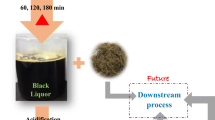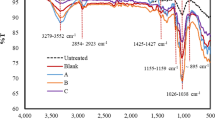Abstract
Delignification has an important role in biomass utilization framework of Empty Fruit Bunch of Palm Oil (EFB). EFB from Sulawesi Island with high lignin reached 45% was a challenge. Innovation for delignification should be delivered to remove lignin but keep holocellulose, cellulose, and hemicellulose. Treated EFB improved accessible the holocellulose for subsequent process like enzymatic process. Delignification would remove or break down lignin to increase the accessibility. Delignification by ozonized NaOH solution conducted at ambient temperature to save energy and low NaOH concentration, 3.2%. Ozonization NaOH solution with 500 ppm H2O2 would produce hydroxyl radical (OH°), an oxydator. ORP, TDS, and TSS of black liquor was observed to assess any suspended and dissolved solid of EFB. Treated EFB was analized for its component, lignin, and holocellulose. At higher NaOH solution was the higher TSS in ozonized NaOH solution. The highest TSS by ozonized 0.8 M NaOH reached 50.810 ppm. Unfortunately, the holocellulose was also decomposed as well. Thus, the yield was decrease since both lignin and holocellulose degraded. Optimal delignification was figure out at 0.4 M or 1.6% NaOH whereas lignin decreasing and holocellulose increasing by 30.8% and 27.17%, respectively. XRD analysis clarified improvement of this delignification for crystallinity increased 8.5%, 69%, closer to α-cellulose. Morphology by SEM showed remove the impurities successfully and Si, Nb, Mg, and Ca detected by EDS.









Similar content being viewed by others
References
Pera-Titus M, García-Molina V, Baños MA, Giménez J, Esplugas S (2004) Degradation of chlorophenols by means of advanced oxidation processes: a general review. Appl Catal B – Environ 47:219–256. https://doi.org/10.1016/j.apcatb.2003.09.010
Vallejo M, Román MFS, Ortiz I, Irabien A (2015) Review: Overview of the PCDD/Fs degradation potential and formation risk in the application of advanced oxidation processes (AOPs) to wastewater treatment. Chemosphere 118:44–56. https://doi.org/10.1016/j.chemosphere.2014.05.077
Zhao Q, Dong X, Zhou M, Wang J (2014) Dioxin destruction by supercritical water oxidation. Adv Mat Res 864–867:1709–1712. https://doi.org/10.4028/www.scientific.net/AMR.864-867.1709
Gogate PR, Pandit AB (2004) A review of imperative technologies for wastewater treatment I: oxidation technologies at ambient conditions. Adv Environ Res 8:501–551. https://doi.org/10.1016/S1093-0191(03)00032-7
BPS-Statistics Indonesia, Indonesian Oil Palm Statistics (2019) ISSN: 1978–9947.
Lacrosse L (2004) Clean and efficient biomass cogeneration technology in ASEAN, in COGEN 3: Business Prospects in Southeast Asia for European Cogeneration Equipment, Krakow, Poland, 23 November 2004.
**u S, Shahbazi A, Li L (2017) Characterization, modification and application of biochar for energy storage and catalysis: a review, trends in renewable energy 3(1):86–101
Muktham R, Bhargava SK, Bankupalli S, Ball AS (2016) A review on 1st and 2nd generation bioethanol production-recent progress. J Sustain Bioenergy Syst 6(03):72–92. https://doi.org/10.4236/jsbs.2016.63008
Lee Y, Yoon TH, Lee J, Jeon SY, Lee JH, Lee MK, Chen H, Yun J, Oh SY, Wen X, Cho HK, Mang H, Kwak JM (2018) A lignin molecular brace controls precision processing of cell walls critical for surface integrity in arabidopsis. Cell 173(6):1468–1480. https://doi.org/10.1016/j.cell.2018.03.060
Sugiwati S, Suaidah S, Triwahyuni E, Muryanto, Andriani Y, Abimanyu H (2021) Hydrolysis of Cellulose from Oil Palm Empty Fruit Bunch using Aspergillus niger.E3S Web Conf 226, 00042. https://doi.org/10.1051/e3sconf/202122600042
Abdullah N, SulaimanGerhauser H (2011) Characterization of Oil Palm Empty Fruit Bunches for Fuel Application. J Phys Sci 22(1):1–24
Chang SH (2014) An overview of empty fruit bunch from oil palm as feedstock for bio-oil production. Biomass Bioenerg 62:174–181
Nasruddin (2012) Delignification empty fruit bunches continued with the palm gradual hydrolysis to produce glucose. J Dinamika Penelitian Ind 23(1). https://doi.org/10.24252/al-kimia.v3i2.1667
Kusmardini D, Prasetyo J, Hudiyono S, Saepudin E (2016) The effectiveness of bio-delignification empty fruit bunch of palm oil by Aspergillus fumigatus: Targeting for Bio-Hydrogen Production. Int J Appl Chem 12(3):411–427, Research India Publications, ISSN 0973–1792.
Kusmardini D, Prasetyo J, Hudiyono S, Saepudin E (2018) Biohydrogen production through separate hydrolysis and fermentation and simultaneous saccharification and fermentation of Empty Fruit Bunch of Palm Oil. Res J Chem Environ 22(Special Issue II):193–197
Mohtar SS, Tengku Malim Busu TN, Md Noor AM, Shaari N, Yusoff NA, Bustam Khalil MA, Abdul Mutalib MI, Mat HB (2015) Extraction and characterization of lignin from oil palm biomass via ionic liquid dissolution and non-toxic aluminium potassium sulfate dodecylhydrate precipitation processes. Biores Technol 192:212–218. https://doi.org/10.1016/j.biortech.2015.05.029
Akhtar J, Teo CL, Lai LW, Hassan N, Idris A, Aziz RA (2015) Factors affecting delignification of oil palm empty fruit bunch by microwave-assisted dilute acid/alkali pretreatment. BioResources 10(1):588–596. https://doi.org/10.15376/BIORES.10.1.588-596
Dewi RK, Zuhroh ST, Zulaikha S (2018) Delignification of candlenut shell waste with alkali pretreatment method as an alternative fuel feedstock. Int J Mech Eng Technol 9(10):271–278. ISSN Print: 0976–6340 and ISSN Online: 0976–6359.
Zuorro A, Lavecchia R (2014) Evaluation of UV/H2O2 advanced oxidation process (AOP) for the degradation of diazo dye Reactive Green 19 in aqueous solution. Desalin Water Treat 52:1571–1577. https://doi.org/10.1080/19443994.2013.787553
Sluiter A, Hames B, Ruiz R, Scarlata C, Sluiter J, Templeton D, Crockeret D (2012) Determination of structural carbohydrates and lignin in biomass, Laboratory Analytical Procedure (LAP), NREL, Revision Date: August 2012 (Version 08–03–2012).
Maryana R, Bardant TB, Ihsan DM, Das AK, Irawan Y, Rizal WA, Triwahyuni E, Muryanto UARI, Sudiyani Y (2022) Reducing sugars and bioethanol production from oil palm empty fruit bunch by applying a batch and continuous pretreatment process with low temperature and pressure. Biomass Convers Biorefinery. https://doi.org/10.1007/s13399-022-03138-0
Prasetyo J, Kato T, Park EY (2010) Efficient cellulase-catalyzed saccharification of untreated paper sludge targeting for biorefinery. Biomass Bioenerg 34:1906–1913. https://doi.org/10.1016/j.biombioe.2010.07.021
Ghose TK (1987) Measurement of cellulase activities. International Union of Pure and Applied Chemistry, Applied Chemistry Division Commission on Biotechnology. Pure Appl Chem 59(2):257–268
SNI 6989.3:2019 (2019) Air dan air limbah – Bagian 3: Cara uji padatan tersuspensi total (Total Suspended Solids, TSS) secara gravimetri, Badan Standardisasi Nasional (BSN), Indonesia.
Shimkevich A (2019) On the galvanic modification of seawater, World Journal of Condensed Matter Physics, 9: 112–121. Sci Res Publ. https://doi.org/10.4236/wjcmp.2019.94009
Park S, Baker JO, Himmel ME, Parilla PA, Johnson DK (2010) Cellulose crystallinity index: measurement techniques and their impact on interpreting cellulase performance. Biotechnol Biofuels 3:10. https://doi.org/10.1186/1754-6834-3-10
Cao S, Ma X, Luo X, Huang F, Huang L, Chen L (2013) Effect of hydroxyl radical on the selectivity of delignification during oxygen delignification of bamboo pulp. Bioresource 8(2):2657–2668
Funding
National Research and Innovation Agency (BRIN), Indonesia (BRIN) provided research funding support for some reagent and analysis for research title PreTreatment Limbah Lignocellulose TKKS dengan Ozonisasi dan Sakarifikasi Ensimatis untuk Produksi Furfural dan HMF, by SK of Head of Organization Research Nomor 2/III/HK/2022. University Pamulang supports research funding for lecturer.
Author information
Authors and Affiliations
Contributions
J. P. is the main contributor who conceptualized and analyzed this work. D.D. and G.W.M. supported analytical method for analysis. R.M. provided raw material, EFB, and analysis. A.T.S. and A.L.M. provided ozonization concept and its application.
Corresponding author
Ethics declarations
Ethics approval
This article does not contain any studies with human or animal participants.
Competing interests
The authors declare no competing interests.
Additional information
Publisher's note
Springer Nature remains neutral with regard to jurisdictional claims in published maps and institutional affiliations.
Rights and permissions
Springer Nature or its licensor (e.g. a society or other partner) holds exclusive rights to this article under a publishing agreement with the author(s) or other rightsholder(s); author self-archiving of the accepted manuscript version of this article is solely governed by the terms of such publishing agreement and applicable law.
About this article
Cite this article
Prasetyo, J., Dahnum, D., Murti, G.W. et al. Delignification of Palm Oil Empty Fruit Bunch by ozonization and its physicochemical effect. Biomass Conv. Bioref. (2023). https://doi.org/10.1007/s13399-022-03719-z
Received:
Revised:
Accepted:
Published:
DOI: https://doi.org/10.1007/s13399-022-03719-z




